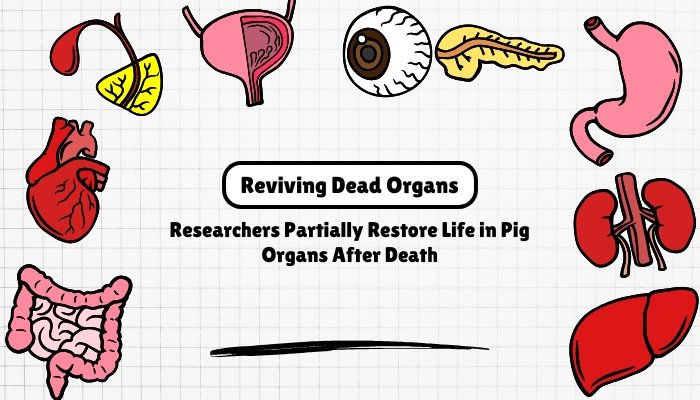Introduction
The boundary between life and death has always been sharply defined in medicine: once the heart stops and circulation ceases, organs rapidly deteriorate. Within minutes, cells begin to die due to lack of oxygen and nutrients. This biological reality has shaped how organ transplants are conducted, with only a short window of opportunity to retrieve viable tissues. However, a groundbreaking study in pigs has challenged this long-held assumption by showing that certain cellular functions in organs can be partially restored even hours after death. This research not only redefines our understanding of death but also raises profound implications for organ transplantation, critical care, and even ethics.
The Study and Its Breakthrough
In 2022, Yale researchers published an experiment in the journal Nature describing how they revived cellular activity in pig organs one hour after the animals had died. They used a specially designed system called OrganEx, which pumped a synthetic solution through the circulatory system. This fluid was not ordinary blood; it was a complex mixture of hemoglobin, nutrients, anti-clotting agents, and anti-inflammatory compounds that helped reduce cell damage and encouraged recovery.
The astonishing outcome was that organs such as the heart, liver, kidneys, and brain showed signs of restored cellular activity. Cells were metabolically active, tissue architecture was preserved, and some electrical signals were detected in the heart and liver. While the pigs did not return to life and consciousness was not restored, the research demonstrated that organ deterioration is not as irreversible as once thought.
How OrganEx Works
OrganEx is essentially a high-tech perfusion system. Its main components include:
- Perfusion Fluid – a synthetic, oxygen-carrying solution enriched with nutrients and protective chemicals.
- Circulatory Pumping – mimics normal blood circulation, delivering oxygen and nutrients across the body.
- Anti-Inflammatory Agents – limit immune responses that can worsen tissue injury after oxygen deprivation.
- Anti-Coagulants – prevent clots from blocking blood flow.
By restarting circulation in this controlled manner, researchers could minimize ischemic injury (damage caused by oxygen deprivation) and re-establish some degree of cellular repair.
Implications for Organ Transplantation
One of the most immediate and practical implications is in organ transplantation. Currently, donated organs must be harvested within a short time after death—usually minutes to a few hours—before damage makes them unusable. With OrganEx technology:
- The window for viable organ retrieval could be extended.
- More organs from deceased donors could be used, reducing the shortage.
- Even marginal or damaged organs might be rehabilitated for transplantation.
This could save thousands of lives every year by expanding the donor pool.
Impact on Critical Care Medicine
The research also has potential relevance to emergency medicine and stroke or cardiac arrest management:
- If cellular activity can be restored after prolonged oxygen loss, it may be possible to salvage tissues that were previously considered irreversibly damaged.
- Treatments for ischemic injuries, such as those caused by heart attacks and strokes, might be revolutionized.
- Resuscitation protocols could evolve beyond traditional CPR and defibrillation.
Ethical Questions
While the pigs were never brought back to full consciousness, the findings raise important ethical and philosophical questions:
- Redefining Death – If organ and cellular functions can be restored after clinical death, how do we define the boundary between life and death?
- Use in Humans – Would it be ethical to attempt this in people who have been declared dead?
- Neuroscience Concerns – In the experiment, there was no evidence of global brain activity, but localized cellular repair was observed. This blurs the line between irreversible brain death and partial cellular recovery.
- Animal Welfare – As experiments advance, maintaining humane standards in animal research is critical.
Scientific Limitations
Despite its promise, OrganEx is not yet ready for clinical use:
- The pigs were anesthetized and never revived to consciousness, so we do not know the full effects of OrganEx on brain function.
- The system restored cellular activity, not full organ function.
- Long-term viability and compatibility with human biology remain untested.
- Clinical translation would require careful regulation, ethical oversight, and years of trials.
The Future of Organ Revival Research
Looking ahead, scientists envision several directions:
- Organ Banking: Organs could potentially be preserved for much longer periods, improving transplant logistics.
- Reparative Medicine: Damaged tissues, such as those after trauma or ischemia, may be repaired in situ using OrganEx-like approaches.
- Understanding Cell Death: This research helps us better understand how cells respond to death and whether death is a gradual, rather than an abrupt, biological event.
- Neuroprotection: Developing targeted therapies for brain ischemia that could prevent irreversible damage after cardiac arrest.
Broader Philosophical and Social Impact
The idea of reviving cellular activity after death touches on profound human questions:
- Could future medicine challenge the permanence of death itself?
- Might organ revival spark debates about extending human lifespan unnaturally?
- Will society accept technologies that blur the line between life and death?
These questions parallel historical shifts in medicine—such as the introduction of ventilators or defibrillators—that once redefined death. Just as “brain death” became a legal standard, we may one day require a rethinking of biological death in light of such technologies.
Conclusion
The Yale pig organ study represents a landmark moment in biomedical science. By partially restoring cellular function hours after death, researchers have demonstrated that death is not an instant event but a process that might be interrupted or reversed at certain stages. The implications are enormous: more transplantable organs, potential new therapies for ischemia, and a re-examination of medical and ethical definitions of death.
However, the technology is in its infancy and faces major hurdles before human application. Ethical frameworks, societal dialogue, and scientific rigor must guide its future. While we are far from “bringing the dead back to life,” this research opens a new frontier in understanding life’s boundaries and may reshape medicine in the decades to come.
Ultimately, OrganEx shows us that the end of life may not be as final as once believed. It offers hope for saving lives and healing damaged organs, while challenging us to carefully navigate the ethical, medical, and philosophical questions that follow.



